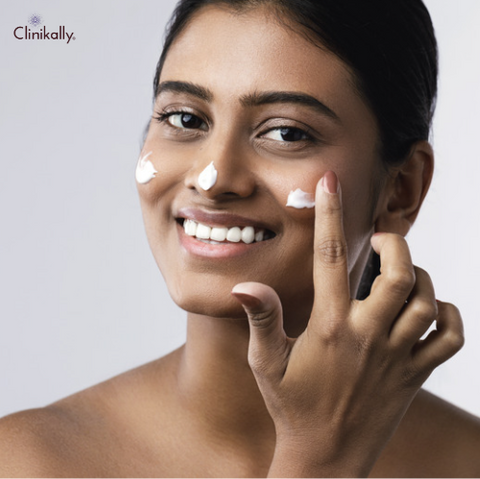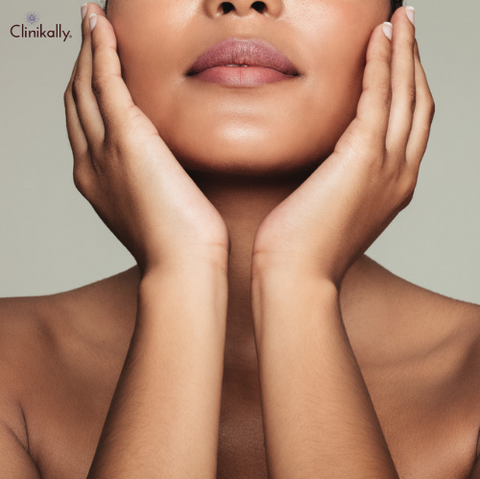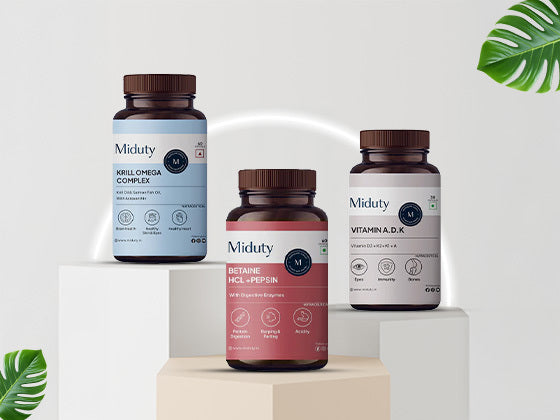Alpha hydroxy acids (AHAs), such as malic acid, can be especially helpful for people with darker skin tones. Some advantages and suggestions for using mandelic acid include its assistance with hyperpigmentation, mild exfoliation, anti-aging capabilities, and acne-fighting abilities. Mandelic acid can be a useful supplement to a skincare regimen for those with darker skin tones who want to reduce the appearance of acne, fine wrinkles, and hyperpigmentation.
What is Mandelic Acid and How Does It Work?

An alpha hydroxy acid (AHA) generated from bitter almonds is mandelic acid. It has a bigger molecule than other AHAs, such as glycolic acid, and as a result, it exfoliates the skin more gently. Mandelic acid helps to expose brighter, smoother skin underneath by reducing the connections that hold dead skin cells together on the skin's surface. Mandelic acid is useful for treating acne since it possesses antibacterial and anti-inflammatory qualities in addition to its exfoliating ones. Additionally, it possesses antioxidant qualities that aid in shielding the skin from oxidative stress brought on by free radicals. A versatile substance, mandelic acid can help with a range of skin issues and concerns. It can be especially helpful for people with darker skin tones because it is less likely than other AHAs to result in post-inflammatory hyperpigmentation. Mandelic acid should be used correctly and in the appropriate concentration, as with any active ingredient, to prevent irritability or other negative reactions.
The Power of Alpha Hydroxy Acids (AHAs)
A category of water-soluble acids known as alpha hydroxy acids (AHAs) is frequently included in cosmetic products. They function by dissolving the connections holding together dead skin cells on the skin's surface, assisting in exfoliation, and revealing younger-looking, smoother skin underneath. AHAs are particularly useful for treating ageing symptoms like wrinkles, fine lines, and uneven skin tone. Additionally, they can help with acne treatment and lessen the appearance of hyperpigmentation, or dark patches. Glycolic acid, lactic acid, and mandelic acid are the AHAs that are most frequently used in skincare. Because it is the smallest molecule and may penetrate the skin more deeply than the other AHAs, glycolic acid is very useful for addressing age-related symptoms. Larger molecules like lactic acid are frequently used in milder formulations for sensitive skin. Mandelic acid, which is much more potent and particularly advantageous for people with darker skin tones because it is less likely to result in post-inflammatory hyperpigmentation, is still larger. While AHAs can have a positive impact on the skin, it's crucial to use them correctly and at the optimal concentration to prevent irritation or other negative effects. AHAs might make the skin more sensitive to the sun, so it's crucial to use sunscreen when using them.
Mandelic Acid: A Gentle AHA for Sensitive Skin
Almonds, which are bitter, are the source of the mild alpha hydroxy acid (AHA) known as mandelic acid. Compared to other AHAs like glycolic and lactic acids, it has a bigger molecule size, which makes it less irritating and better tolerated by people with sensitive skin. Mandelic acid is a powerful component for treating acne and preventing new outbreaks because it is also known for having antibacterial effects. Additionally, it aids in lessening the visibility of wrinkles, fine lines, and hyperpigmentation.
The ability of mandelic acid to enhance skin texture and tone without producing irritation or inflammation is one of its special advantages. As a result, it's a fantastic solution for those with sensitive skin and those with darker skin tones who might be more susceptible to post-inflammatory hyperpigmentation. Mandelic acid should be applied appropriately to prevent irritation and over-exfoliation, just as with other AHAs. To preserve the skin and prevent future harm, it's crucial to apply a moisturiser and sunscreen after. To make sure there are no negative reactions, it is always a good idea to conduct a patch test before using any new skincare component.
Benefits of Mandelic Acid for Darker Skin Tones

People with darker skin tones can benefit from mandelic acid in a variety of ways. Among these advantages are:
-
Improved texture and tone: A mild exfoliator that can help to enhance skin tone and texture is Mandelic acid. It can assist in making wrinkles, fine lines, and hyperpigmentation less noticeable, giving the skin a smoother, more even appearance.
-
Reduced risk of post-inflammatory hyperpigmentation (PIH): PIH, or the darkening of the skin that can happen after an inflammatory response, such as a breakout or injury, is more common in those with darker skin tones. Mandelic acid is a mild exfoliator that can lessen irritation and speed up skin cell turnover to help prevent PIH.
-
Antibacterial properties: Acne can be prevented and treated with the use of the antibacterial characteristics of mandelic acid. It can assist with pore cleaning, inflammation relief, and breakout prevention.
-
Anti-aging properties: The production of collagen may be boosted by mandelic acid, which may assist to lessen the appearance of fine lines and wrinkles. It can also increase the hardness and elasticity of the skin.
-
Safe for sensitive skin: The gentle exfoliator mandelic acid is easily tolerated by people with sensitive skin. Compared to other AHAs like glycolic and lactic acid, it has a bigger molecule size, which makes it less irritating and better tolerated by people with sensitive skin.
If you're searching for a mild exfoliator that can help to improve skin texture and tone, lower the risk of PIH, and offer anti-aging and antibacterial properties, mandelic acid is an excellent alternative.
Treating Hyperpigmentation and Uneven Skin Tone
Common skin issues like hyperpigmentation and uneven skin tone can be treated with a variety of skin care products and methods. Here are some suggestions to help reduce the look of skin discoloration and hyperpigmentation:
-
Sun protection: Sun exposure can exacerbate skin tone and hyperpigmentation issues. Use broad-spectrum sunscreen daily with an SPF of at least 30, and stay out of the sun when it's most intense.
-
Exfoliation: Exfoliation on a regular basis can help to remove dead skin cells and encourage skin cell turnover, which can help to lessen the appearance of hyperpigmentation and uneven skin tone. Salicylic acid and other AHAs and BHAs, like glycolic and mandelic acids, are particularly effective chemical exfoliants.
-
Vitamin C: Vitamin C is an antioxidant that can help to lighten skin tone and make hyperpigmentation appear less prominent. Find a vitamin C serum or moisturiser to add to your regimen.
-
Niacinamide: Niacinamide, a vitamin B3 derivative, can help to lessen inflammation, enhance the texture of the skin, and lessen hyperpigmentation.
-
Azelaic acid: Studies have demonstrated the efficiency of azelaic acid in reducing hyperpigmentation and enhancing skin texture. It also has antibacterial qualities and can aid in minimising acne's appearance.
-
Retinoids: Retinoids, such as retinol or tretinoin, can help to lessen the appearance of skin discoloration and hyperpigmentation. They function by encouraging collagen production and skin cell turnover.
-
Professional procedures: Chemical peels, microdermabrasion, and laser therapy are examples of professional procedures that can effectively treat hyperpigmentation and uneven skin tone. To find the best course of action for your skin, speak with a dermatologist or esthetician.
It's crucial to keep in mind that consistency is essential if you want to see improvement in hyperpigmentation and uneven skin tone. Be persistent and continue your usual skincare routine using the aforementioned products and methods.
Acne Management for Clearer Skin
Acne is a frequent skin issue that can be controlled with the right skincare regimen and lifestyle choices. The following advice will help you control acne and get smoother skin:
-
Keep your skin clean: Wash your face twice daily, after you've perspired, and with a mild cleanser. Avoid overwashing or using abrasive scrubs as these practices can strip the skin of its natural oils and exacerbate acne.
-
Use non-comedogenic products: Keep an eye out for skincare and makeup items that are non-comedogenic, which means they won't clog pores.
-
Exfoliate regularly: Exfoliation on a regular basis can help clear clogged pores and stop acne outbreaks. Effective chemical exfoliants include BHAs (like salicylic acid) and AHAs (like glycolic or mandelic acid).
-
Use spot treatments: Benzoyl peroxide, salicylic acid, or tea tree oil are all effective acne spot treatments that can help minimise acne blemishes.
-
Maintain a healthy diet: Eating a diet high in whole foods, low in processed foods, and low in sugary foods can help to reduce inflammation and encourage healthy skin.
-
Manage stress: Because stress can make acne outbreaks worse, it's critical to manage stress using techniques like exercise, meditation, or therapy.
-
Consider seeing a dermatologist: Consider visiting a dermatologist for prescription drugs such as topical or oral antibiotics, retinoids, or hormone therapy if over-the-counter remedies are ineffective.
Keep in mind that getting clearer skin requires patience and perseverance. Don't be hesitant to seek expert assistance if necessary. Be patient and consistent with your skin care regimen and lifestyle choices.
Smoothing Skin Texture and Fine Lines
Mandelic acid can help smooth skin texture and minimise the appearance of fine wrinkles in addition to treating acne. The following advice will help you use mandelic acid to get these advantages:
-
Start with a low concentration: To give your skin time to adjust, start using mandelic acid at a low concentration (around 5%). If necessary, you can gradually sharpen your focus over time.
-
Use regularly: Mandelic acid works best when used consistently for anti-aging and smoothing effects. As your skin becomes accustomed to it, gradually increase usage to 2-3 times a week from once.
-
Follow with hydrating products: To avoid dryness and flakiness after using mandelic acid, make careful to use moisturising products like a moisturiser or face oil.
-
Protect your skin from the sun: Wear a broad-spectrum sunscreen with an SPF of 30 or higher every day because exposure to the sun can exacerbate the appearance of small wrinkles and uneven texture.
-
Take into account additional anti-aging components: For enhanced effects, combine mandelic acid with retinoids or vitamin C. However, it's crucial to incorporate these ingredients gradually and keep an eye out for any irritation symptoms on your skin.
It may take some trial and error to locate the best mandelic acid product and routine for your skin because everyone's skin is unique. A dermatologist or other skincare expert can provide you with more specific advice.
How to Use Mandelic Acid Safely and Effectively for Darker Skin

Mandelic acid can be safe and effective for darker skin tones when used properly. Here are some tips for using mandelic acid safely and effectively:
-
Start with a modest concentration (about 5%) of mandelic acid if you've never used it before to give your skin time to acclimatise. If necessary, you can gradually sharpen your focus over time.
-
Perform a patch test on a small area of skin before applying mandelic acid to your face to check for any symptoms of irritability or an allergic reaction.
-
Make sure to apply a broad-spectrum sunscreen with SPF 30 or higher every day to protect your skin because mandelic acid can make your skin more susceptible to the sun.
-
Combining different exfoliants, such as mandelic acid and a physical exfoliator, can increase the chance of skin irritation and deterioration. Use one exfoliating product at a time at all times.
-
To avoid dryness and flakiness after using mandelic acid, make careful use of moisturising products like a moisturiser or face oil.
-
It's always a good idea to seek the advice of a dermatologist or skincare expert if you have any questions about applying mandelic acid to your skin in order to receive personalised recommendations.
When utilising mandelic acid, keep in mind that patience and consistency are key. Everyone's skin is unique, so it may take some time to notice the benefits. Because of this, it's crucial to pay attention to your skin and modify your routine as necessary.
Introducing Mandelic Acid into Your Skincare Routine
If you're interested in incorporating mandelic acid into your skincare routine, here are some tips to get started:
-
Start slowly: It's important to start slowly and gradually increase frequency and concentration over time when using any new skincare ingredient. Start with a low concentration of mandelic acid and use it once per week. If your skin tolerates it well, you can gradually increase the frequency to 2-3 times per week.
-
Choose the right product: Look for a mandelic acid product that is designed for the needs and problems of your skin. Some products might work better on skin that is prone to breakouts, while others might be developed to address hyperpigmentation or uneven skin tone.
-
Cleanse your skin first: Make sure your skin is dry and clean before applying mandelic acid. Use a gentle cleanser to remove any dirt, oil, or makeup from your skin.
-
Apply a small amount: Begin by applying a small amount of mandelic acid evenly to your skin, keeping the eye area out of the area. Before using any additional skincare products, give them a few minutes to absorb into your skin.
-
Apply a moisturiser: Mandelic acid can be drying, so apply one after to hydrate and shield your skin.
-
Use sunscreen: Mandelic acid can increase your skin's sensitivity to the sun, just like any other exfoliating product. Even if you don't spend much time outside, make sure to use a broad-spectrum sunscreen with at least SPF 30 every day.
It's important to pay attention to how your skin responds to mandelic acid and modify your routine as necessary because everyone's skin is unique. Reduce the frequency of use or stop using it altogether if you feel any irritability or discomfort. And as always, it's best to speak with a dermatologist or skincare expert if you have any concerns.
Choosing the Right Mandelic Acid Product
A few things should be taken into account when selecting a mandelic acid product including:
-
Concentration: The concentration of mandelic acid in various products can range from 5% to 20%. The best course of action is to start with a lower concentration and gradually work your way up if you are new to using mandelic acid or have sensitive skin.
-
pH level: Mandelic acid works best at pH levels between 3.5 and 4.5. To make sure you are using a formulation that works, look for products whose labels state the pH level.
-
Formulation: Mandelic acid is available in a variety of formulations, including toners, serums, and masks. Consider your skin type and personal preferences when choosing a formulation.
-
Additional ingredients: In addition to mandelic acid, some products may also include hyaluronic acid, niacinamide, or antioxidants. Look for products with ingredients that address the specific skincare issues you have.
-
Brand reputation: Look for products containing mandelic acid from reputable companies that have a proven track record of creating safe and efficient skincare products.
To make sure you don't have a negative reaction, it's also crucial to patch-test any new mandelic acid product before using it all over your face.
Important Precautions and Aftercare Tips
Mandelic acid is typically regarded as being safe for the majority of people, but it's crucial to take certain measures and adhere to aftercare instructions to prevent any negative reactions. Following are some crucial safety advice and recommendations for aftercare when using mandelic acid:
-
Patch test: To make sure you don't have a negative reaction, apply mandelic acid to a small area of the skin before applying it all over your face.
-
Start slowly: If you're new to using mandelic acid, start with a lower concentration and work your way up gradually to avoid irritation.
-
Use sunscreen: Mandelic acid can make your skin more sensitive to the sun, so whenever you go outside, you should wear broad-spectrum sunscreen with an SPF of at least 30.
-
Avoid using other exfoliants: To prevent over-exfoliation and potential irritation, avoid using other exfoliants, such as scrubs or peels, while using mandelic acid.
-
Moisturise: Apply a moisturiser to your skin to keep it hydrated and to help restore its natural barrier function.
-
Avoid using retinoids: Mandelic acid should not be combined with retinoids or other vitamin A derivatives because it can cause skin irritation.
-
Consult a dermatologist: Before using any new skincare products, including mandelic acid, it's always a good idea to consult a dermatologist if you have any underlying skin conditions or concerns.
Mandelic acid is an all-around gentle and efficient AHA that can help with the appearance of acne, uneven skin tone, and dark spots. You can safely incorporate mandelic acid into your skincare routine and achieve a brighter, clearer complexion by taking precautions and following aftercare tips.









































